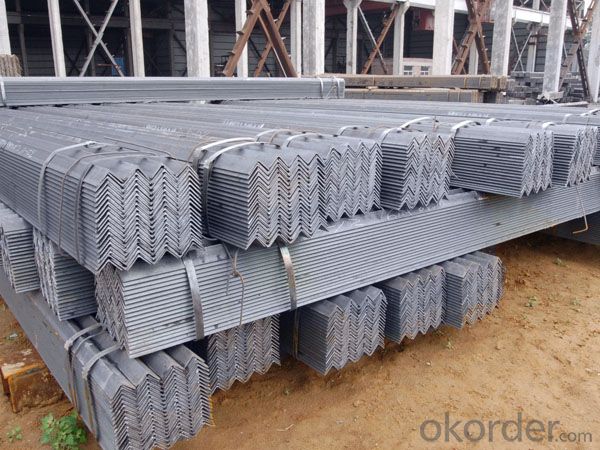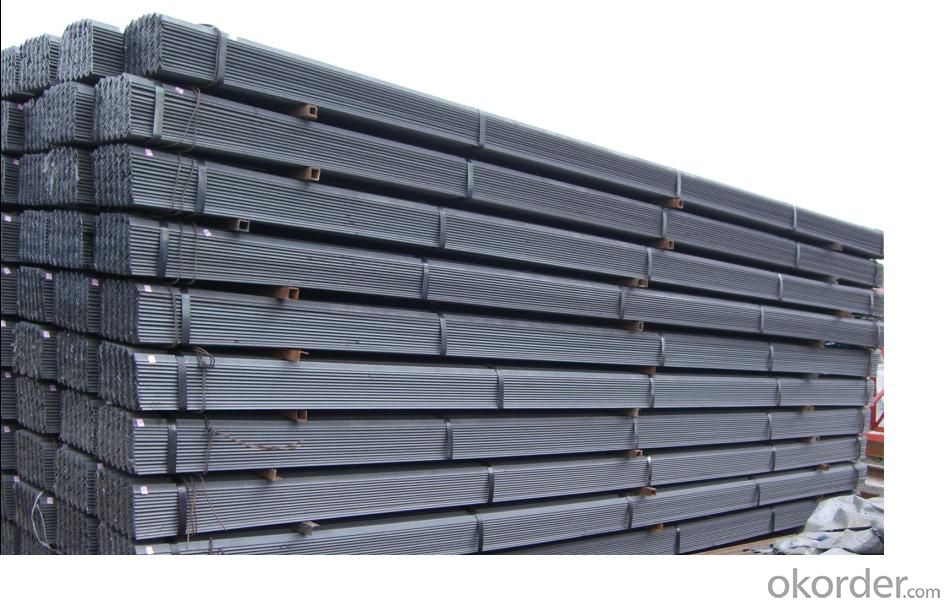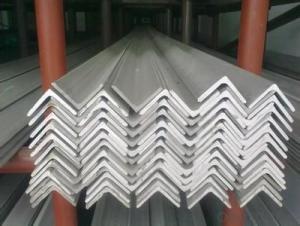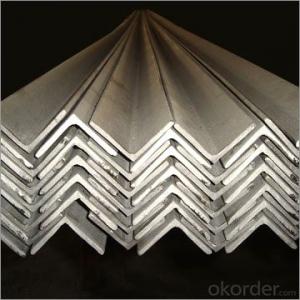ANGLE STEEL HOT ROLLED 20MM-250MM S235JR S335JR
- Loading Port:
- Tianjin
- Payment Terms:
- TT OR LC
- Min Order Qty:
- 25 m.t.
- Supply Capability:
- 200000 m.t./month
OKorder Service Pledge
OKorder Financial Service
You Might Also Like
Item specifice
Product Description:
OKorder is offering high quality Hot Rolled Steel I-Beams at great prices with worldwide shipping. Our supplier is a world-class manufacturer of steel, with our products utilized the world over. OKorder annually supplies products to European, North American and Asian markets. We provide quotations within 24 hours of receiving an inquiry and guarantee competitive prices.
Product Applications:
According to the needs of different structures, Angle can compose to different force support component, and also can be the connections between components. It is widely used in various building structures and engineering structures such as roof beams, bridges, transmission towers, hoisting machinery and transport machinery, ships, industrial furnaces, reaction tower, container frame and warehouse etc
Product Advantages:
OKorder's ANGLE STEEL HOT ROLLED 20MM-250MM S235JR S335JR are durable, strong, and resist corrosion.
Main Product Features:
· Premium quality
· Prompt delivery & seaworthy packing (30 days after receiving deposit)
· Corrosion resistance
· Can be recycled and reused
· Mill test certification
· Professional Service
· Competitive pricing
Product Specifications:
Manufacture: Hot rolled
Grade: Q195 – 235
Certificates: ISO, SGS, BV, CIQ
Length: 6m – 12m, as per customer request
Packaging: Export packing, nude packing, bundled
Sizes: 25mm-250mm | ||||||||||||
a*t | ||||||||||||
25*2.5-4.0 | 70*6.0-9.0 | 130*9.0-15 | ||||||||||
30*2.5-6.6 | 75*6.0-9.0 | 140*10-14 | ||||||||||
36*3.0-5.0 | 80*5.0-10 | 150*10-20 | ||||||||||
38*2.3-6.0 | 90*7.0-10 | 160*10-16 | ||||||||||
40*3.0-5.0 | 100*6.0-12 | 175*12-15 | ||||||||||
45*4.0-6.0 | 110*8.0-10 | 180*12-18 | ||||||||||
50*4.0-6.0 | 120*6.0-15 | 200*14-25 | ||||||||||
60*4.0-8.0 | 125*8.0-14 | 250*25 | ||||||||||
FAQ:
Q1: Why buy Materials & Equipment from OKorder.com?
A1: All products offered byOKorder.com are carefully selected from China's most reliable manufacturing enterprises. Through its ISO certifications, OKorder.com adheres to the highest standards and a commitment to supply chain safety and customer satisfaction.
Q2: How do we guarantee the quality of our products?
A2: We have established an advanced quality management system which conducts strict quality tests at every step, from raw materials to the final product. At the same time, we provide extensive follow-up service assurances as required.
Q3: How soon can we receive the product after purchase?
A3: Within three days of placing an order, we will begin production. The specific shipping date is dependent upon international and government factors, but is typically 7 to 10 workdays.


- Q:How do steel angles contribute to the overall stiffness of a structure?
- Steel angles contribute to the overall stiffness of a structure in several ways. First and foremost, they provide additional support and rigidity to the framework of the structure. Due to their L-shape, steel angles can be used to reinforce the corners and edges of various components, such as beams, columns, and trusses. This reinforcement helps to prevent buckling, twisting, or bending that may occur under heavy loads or external forces. Moreover, steel angles can be strategically placed at key locations within a structure to resist and distribute loads more efficiently. By adding steel angles as bracing elements, the overall stiffness of the structure is enhanced, reducing the chances of excessive deflection or deformation. This is particularly important in structures that are subjected to dynamic loads, such as wind or seismic forces, as the angles help to resist and dissipate these forces throughout the structure. Additionally, steel angles can be interconnected to form a network of diagonal bracing, which significantly improves the overall stiffness and stability of the structure. This bracing system allows the angles to transfer loads from one component to another, effectively reducing the risk of failure or collapse. The use of steel angles in this manner can also help to minimize the amount of material and weight required, making the structure more cost-effective and efficient. In summary, steel angles play a crucial role in contributing to the overall stiffness of a structure by providing reinforcement, supporting key components, and distributing loads. Their versatility and strength make them an essential element in the design and construction of various types of structures, ensuring their stability, durability, and safety.
- Q:What is the typical length of a steel angle?
- Steel angles can have varying lengths depending on their purpose and application. Generally, a steel angle is commonly found at a length of 20 feet or 6 meters. This standard length facilitates convenient handling, transportation, and installation in diverse construction and fabrication projects. Nevertheless, it is important to acknowledge that steel angles can be tailored or trimmed to shorter lengths in order to meet specific requirements or accommodate specific designs.
- Q:Can steel angles be used for framing in modular homes?
- Yes, steel angles can be used for framing in modular homes. Steel angles are commonly used in construction for their strength and durability. They are versatile and can be used in various applications, including framing. Steel angles provide excellent load-bearing capacity and structural support, making them suitable for modular home construction. Additionally, steel angles can be easily fabricated and customized to meet specific design requirements. Their resistance to corrosion and fire also adds to their suitability for modular home framing. Overall, steel angles are a reliable and efficient choice for framing in modular homes.
- Q:What are the different types of steel angles used in machinery?
- There are several different types of steel angles that are commonly used in machinery. One of the most common types is the equal-leg angle, also known as L-shaped or L-angle steel. This angle has equal dimensions on both sides, forming a 90-degree angle. It is commonly used in machinery to provide structural support and stability, as well as to reinforce joints and connections. Another type is the unequal-leg angle, which has different dimensions on each side, resulting in an uneven angle. This type of angle is often used in machinery where specific weight distribution or load-bearing requirements need to be met, as it allows for greater flexibility in design. Additionally, there are also rounded steel angles, also known as rounded corner angles or round bars. These angles have rounded edges instead of sharp corners, making them ideal for machinery applications where safety is a concern, as they reduce the risk of injury from sharp edges. Furthermore, there are slotted steel angles, which have one or more holes or slots along their length. These slots allow for easy adjustment and mounting of components, making them suitable for machinery that requires frequent modifications or customization. Lastly, stainless steel angles are another type commonly used in machinery. Stainless steel offers excellent corrosion resistance, making it ideal for machinery that operates in harsh or corrosive environments, such as marine or chemical applications. Overall, the choice of steel angle in machinery depends on the specific requirements of the application, including structural needs, load-bearing capacity, safety considerations, and environmental factors.
- Q:What is the maximum load capacity for a steel angle beam?
- The maximum load capacity of a steel angle beam is influenced by several factors, including the beam's size and dimensions, the grade of steel employed, and the intended use or application. While steel angle beams are frequently utilized in construction and structural contexts to bear loads, the precise maximum load capacity may differ. To ascertain the specific maximum load capacity of a steel angle beam in a given scenario, it is crucial to refer to engineering specifications, structural design codes, or seek guidance from a structural engineer.
- Q:How do you calculate the maximum allowable stress for a steel angle?
- To calculate the maximum allowable stress for a steel angle, you need to consider both the material properties of the steel and the specific geometry of the angle. Here are the steps to determine the maximum allowable stress: 1. Determine the material properties: Find the yield strength (or tensile strength) of the steel angle. This information can typically be found in engineering handbooks or material specification documents. The yield strength represents the maximum stress that the steel can withstand without permanent deformation. 2. Consider the safety factor: Determine the desired safety factor for the application. The safety factor represents a margin of safety between the calculated maximum stress and the actual applied stress. Common safety factors range from 1.5 to 4, depending on the specific application and industry standards. 3. Calculate the maximum allowable stress: Multiply the yield strength of the steel by the safety factor. This will give you the maximum allowable stress for the steel angle. The formula is as follows: Maximum Allowable Stress = Yield Strength × Safety Factor For example, if the yield strength of the steel angle is 300 MPa and the desired safety factor is 2, the maximum allowable stress would be: Maximum Allowable Stress = 300 MPa × 2 = 600 MPa Remember to use consistent units throughout the calculation, whether it is in megapascals (MPa), pounds per square inch (psi), or any other unit of stress. It is important to note that this calculation assumes the steel angle is subjected to a uniaxial stress state. If the angle is subjected to bending or torsional loads, additional calculations would be required to determine the maximum allowable stress based on the specific loading conditions and the angle's geometric properties.
- Q:Can steel angles be used in the construction of power plants?
- Steel angles are indeed suitable for use in power plant construction. They are frequently employed to provide structural support and stability, as well as to withstand heavy loads. In power plant construction, steel angles have several applications, including framing structural components, supporting machinery, reinforcing concrete structures, and ensuring the overall structural integrity of the plant. Moreover, steel angles are highly resistant to corrosion, which is especially crucial in power plants where they are exposed to high temperatures, moisture, and chemicals. Thus, the versatility, strength, and durability of steel angles make them an excellent option for constructing power plants.
- Q:What are the different testing methods used for quality control of steel angles?
- There are several testing methods used for quality control of steel angles. These include visual inspection, dimensional measurements, ultrasonic testing, magnetic particle inspection, and load testing. Visual inspection involves visually examining the steel angles for any surface defects or imperfections. Dimensional measurements ensure that the angles meet the specified size and shape requirements. Ultrasonic testing uses sound waves to detect any internal flaws or discontinuities in the material. Magnetic particle inspection involves applying a magnetic field to the angles and using magnetic particles to identify any surface cracks or defects. Lastly, load testing involves subjecting the angles to a predetermined load to determine their strength and structural integrity. These testing methods help ensure that the steel angles meet the required quality standards.
- Q:Are steel angles available in non-standard dimensions?
- Steel angles in non-standard dimensions can be obtained. Although standard steel angles are typically manufactured in specific sizes, such as 2x2 inches or 3x3 inches, there are manufacturers and suppliers capable of producing steel angles in custom sizes to fulfill specific project requirements. These custom sizes may involve varying leg lengths, thicknesses, or overall dimensions that are not commonly found in standard steel angles. Achieving the desired dimensions can be accomplished through processes like cutting, bending, and welding when fabricating custom steel angles. Nevertheless, it is important to consider that non-standard dimensions may result in additional time and cost for production compared to readily available standard sizes.
- Q:Can steel angles be used for manufacturing ladders?
- Indeed, ladders can be manufactured using steel angles. The reason behind their frequent usage in ladder construction lies in their robustness and long-lasting nature. As they provide a solid framework and endure heavy burdens, they prove to be apt for ladder purposes. Moreover, steel angles exhibit resistance against bending and twisting, guaranteeing stability and security during ascent. Furthermore, they can be effortlessly joined together through welding or bolting to form the desired ladder structure. All in all, steel angles serve as a dependable option for ladder manufacturing.
1. Manufacturer Overview |
|
|---|---|
| Location | |
| Year Established | |
| Annual Output Value | |
| Main Markets | |
| Company Certifications | |
2. Manufacturer Certificates |
|
|---|---|
| a) Certification Name | |
| Range | |
| Reference | |
| Validity Period | |
3. Manufacturer Capability |
|
|---|---|
| a)Trade Capacity | |
| Nearest Port | |
| Export Percentage | |
| No.of Employees in Trade Department | |
| Language Spoken: | |
| b)Factory Information | |
| Factory Size: | |
| No. of Production Lines | |
| Contract Manufacturing | |
| Product Price Range | |
Send your message to us
ANGLE STEEL HOT ROLLED 20MM-250MM S235JR S335JR
- Loading Port:
- Tianjin
- Payment Terms:
- TT OR LC
- Min Order Qty:
- 25 m.t.
- Supply Capability:
- 200000 m.t./month
OKorder Service Pledge
OKorder Financial Service
Similar products
New products
Hot products
Related keywords




























